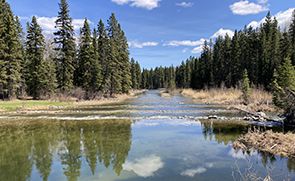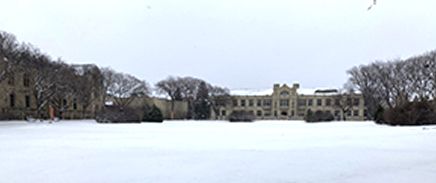Analytical aspects of a 6-field fluid model with linear pressure energy.

|

|
| Nom | Laboratoire | Durée | Destination | Laboratoire d'accueil |
|
Daniele Villa 
|
PIIM | 3 mois | Canada, Saskatchewan |
University of Saskatchewan, Department of Physics and Engineering Physics - Theoretical Plasma Physics |
Within the frame of the Ph.D. project being carried out at the University of Aix-Marseille by myself, Daniele Villa, in the PTM team (PIIM UMR 7345), a mobility period to the University of Saskatchewan, in Saskatoon (Canada), took place from the 1st of March to the 31st of May. During this time my supervisors (Olivier Agullo and Nicolas Dubuit) and I collaborated with the host researcher, Prof. Andrei Smolyakov, on a number of topics that had been agreed upon before the start of the collaboration.
In order to better explain the work done, here follow a few words on the topic of the Ph.D. In the field of plasma physics, specifically of thermonuclear fusion by magnetic confinement, an area where the knowledge of the community is still incomplete is that of the interaction between turbulence and magnetic islands. Turbulence refers to the small-scale fluctuations of the plasma that give rise to flows and diffusion in the fluid, affecting the performance and stability of a potential nuclear reactor, while magnetic islands are large scale phenomena linked to the modification of the magnetic field used to confine the plasma itself. Magnetic islands are known to be particularly problematic for a potential reactor as their presence increases the risk of abrupt ejections of heat from the plasma (a so-called disruption) that would damage the machine, while at the same time limiting the maximum performance achievable. The complex dynamics and high computational cost to investigate such interaction has caused a reduced number of studies to be carried out on the topic. The team in Marseille has, however, developed a fluid code named “AMON” that allows to study self-consistently the interactions on such a wide spectrum of spatial and temporal scales, making the study of such interactions possible, and indeed already happen in certain contexts (Dubuit, PoP, 2021; Muraglia, PRL, 2011; Agullo, PoP, 2017).
The original goal of the Ph.D. project was that of focusing specifically on this interaction, exploring different contexts and scenarios, using a model recently developed by the TPM team at the University of Aix-Marseille (Frank et al., PoP, 2020) to carry out numerical and analytical studies. This model is based on the more streamlined and computationally light models already in use in the team, that have been extended with the specific goal of carrying out studies like the one envisioned for the Ph.D. project, related to phenomena of relevance for real-world applications.
Over the first year of the project, however, it became clear that the model itself needed some refining and reviewing to better suit the task, especially when an interesting and never before observed phenomenon related to the plasma pressure increasing in the presence of magnetic islands appeared in simulations. This result is not only new and unforeseen, but potentially far-reaching in its consequences for the analysis of real-world discharges, as the state-of-the-art understanding of magnetic islands dynamics is that pressure should be flattened inside the region of the plasma contained in the island (Fitzpatrick, 1995), and not show the local increase we get in our simulations, thus a very interesting new venue for investigation could be opened by our results.
Since this heating phenomenon, that constitutes the subject of a paper soon to be submitted, was made possible by some specific terms in the model that the team in Marseille had never dealt with before, the help of an external expert was sought, and Prof. Andrei Smolyakov showed interest in the subject.
The University of Saskatchewan hosts not only very prominent scientists for the theory of plasma physics, but also a number of experiments in the field, including a small compact Tokamak, known as STOR-M. I had the chance to learn about this machine and meet the people who conduct experiments on it during my stay.
Indeed, the first month and a half of the mobility was dedicated to identifying, understanding and fixing certain issues existing within the model, which more or less led to the model being rebuilt from the ground up, with significant improvements in its physical basis and reliability. Comparisons of this model to other existing and similar models ( GBS as described in Giacomin, submitted, 2021 and GRILLIX as described in Appendix A of Zholobenko, PPCF, 2021 ) were carried out, finding that, in the appropriate limits, the equations matched those of these pre-existing models. A consequence of this is that the model is now capable of allowing more in depth and accurate studies of the non-linear dynamics of systems, that will be crucial going forward in the Ph.D. to study the aforementioned interaction between magnetic islands and turbulence. It is also the case that the team in Marseille can now, to a degree, replicate and validate studies done by the teams using the codes indicated above, that, to our knowledge, have not been used to study the dynamics of magnetic islands yet. The focus was then shifted to the implementation of the new model into the existing numerical framework AMON established at the TPM group at the University of Aix-Marseille. This required some time to implement all the new elements of the model and properly test the code, making sure that results were reliable and understanding the properties of the new model.
With this new model the analysis done about the heating effect was carried out a-new, recovering the previous results, along with some new interesting elements, with a more robust model and a better understanding, on my part at least, of the physical processes involved, thus leading to the revision of the paper that is going to be submitted in the coming weeks.
The remaining time in Canada was spent, on the one hand, further working on the model to recover, with this more rigorous approach, certain features present in Frank et al., PoP, 2020, that had been put aside in the re-derivation of the new model, which will be useful for the continuation of the Ph.D. project. Such elements include the neoclassical terms, that allow to study a group of phenomena of great interest for modern fusion experiments, like Neoclassical Tearing Modes, a particular type of magnetic island that arises in large scale experiments limiting their operational possibilities, and that we plan to start including in our analysis in the near future. These neoclassical terms are not often included in fluid codes, but including them, in the appropriate regime, might provide further insight into the dynamics of real-world plasmas. On the other hand, during the remaining time in Saskatoon, the topic of the properties of turbulence itself in thermonuclear plasmas was expanded upon, in particular the effect of the plasma pressure on turbulence, as the turbulence transitions from electrostatic to electromagnetic. This is the second element that I’ll need to study in detail in the remainder of my project to then move to the analysis of the interaction of this with magnetic islands.
On this latter point, the work in the paper by Hirose, PoP, 2000, was re-analyzed from a numerical as well as analytical point of view, which is of particular interest going forward in the Ph.D. as the interaction between magnetic islands and turbulence we aim to study is of particular interest when it comes to Ion-Temperature-Gradient turbulence, studied in the above mentioned paper, that is particularly active in the core region of thermonuclear plasmas. Indeed, going forward, we aim to study more in depth the generation of magnetic islands by this kind of turbulence, the way the turbulence interacts with a pre-existing island and, finally, how this extends to the case of Neoclassical Tearing Modes, which will be of great interest for real-world applications.
The paper is also carried out, for a good portion, with a kinetic model, which is a much more fundamental description of the dynamics of plasmas compared to the fluid model described above. This approach to the study of plasma physics had not been explored in depth in the Ph.D. project up to this point, and this allowed me to obtain meaningful insight and skills on this topic.
The work done on the paper by Hirose was also a chance to develop code that could be applied to answer concrete questions, like finding eigenvalues for differential equations, and was also a chance to go hands-on with programming techniques such as multi-process parallelization with MPI and GPU computing, of which, up to this point, I had mostly been a user, never a developer.
As can be seen the mobility period lead to concrete and significant results already, that are in line with the initial goals we had set for ourselves, and has provided a lot of interesting material to work on for time to come.
On a more personal note, the possibility of dedicating myself to the task of analyzing and re-building the model from a first principle perspective has provided me with very precious insight, that I felt I was lacking with the more numerically-centered approach we were using in Marseille, and I thus feel like I have acquired a much more solid knowledge and understanding of the fluid description of plasmas. This will be invaluable going forward in the Ph.D. project and in my research career.
Also invaluable is the lesson learned when looking back on the work done thus far in the Ph.D. project of truly applying critical reasoning when approaching a problem and being presented with results, going in depth until all questions are answered.
More generally, the possibility of shifting perspective and getting input from new and different sources has proven very beneficial.
While I was not able to create a lot connections with researches working in a field similar to mine, since, like in Marseille, not many people work on a topic similar to mine at the University of Saskatchewan, I still had the chance to learn a lot about other fields of research by meeting colleagues and other students, as well as by learning about the research being carried out at the University of Saskatchewan. This was also a useful lesson in carrying out work independently, as not having frequent contact with my supervisors forced me to deal with problems on my own and “learn by doing”.
Still, at the University of Saskatchewan there are numerous interesting fields of research being explored, not only in Physics, so I got to discuss with people working on cold/dusty plasmas, veterinarians, cancer researchers and many others, in a stimulating and dynamic environment. Learning about the realities of the education system in North-American countries has also been extremely eye-opening and invaluable even for future life choices.
Visiting Canada has been an extremely exciting experience, that allowed me to meet people from many various, and different to my own, backgrounds, discover what life is like in a North American country and travel to places that I might not have had the chance to visit as easily otherwise, both cities and wild areas. Coming from two years of Covid-19 pandemic, the possibility of traveling across the ocean and working with people face-to-face has been a very welcome change.
In conclusion, the experience has been very positive and formative, and I consider periods of mobility like these to be fundamental in the education of young researchers, and young people more in general. I am very grateful for the chance I was given by the University, and for the funds dedicated to this project by the ISFIN, as well as to my supervisors for according me the time and to the host researcher for taking on the project.
This is an experience I’ll definitely support and encourage others to undertake in the future.

